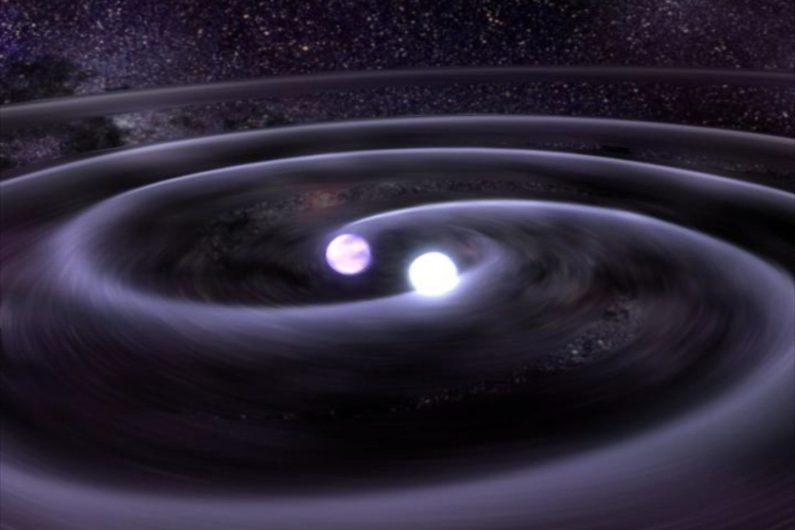“What is the sound of one hand clapping?” ask the Zen masters. Scientists do not have a ready answer for that one — but last week they did record the sound of two black holes merging, a sound that had never before been heard by humans.
Using two massive sensors, one located in Louisiana and the other in Washington state, they recorded a brief rrrrrrruupp! wave disturbance created by the merging of two massive black holes. An event that occurred more than one billion light-years away. One light-year is about 5.88 trillion miles, which means this little quail-like chirp scientists recorded on Thursday, February 11, was made by an event happening at a distance of 5,880,000,000,000,000,000,000 miles.
So, not very close.
And think about it in terms not of space but of time: this chirp was made by something that happened more than a billion years ago. And in order to record this signal, they had to be able to measure movements in their detectors of less than one ten-thousandth the width of a single proton.
So, pretty small.
The sheer fact that we could detect this signal at such a distance, in both time and space is astonishing. What’s more, the event offered a confirmation of Einstein’s century-old prediction of gravitational waves. So as a scientific achievement, it was epic in every way.
Yet what struck me most was the nature of the event itself. Picture this:
Two black holes, the most massive entities in the known universe, approach each other and start revolving around each other. Their mass is so great — one is about 36 times more massive than our sun, the other 29 times as massive — that their dance carves gigantic distortions in space and time. In a fraction of a second (or an eon, depending on where you’re standing) they merge into an odd new shape, which then smoothes itself and becomes a new black hole, this one having 62 times the mass of our sun.
Wait. 36 + 29 = 65 … not 62.
So where did the other 3 sun-masses go? They turned into energy — gravitational waves — that broadcast out into space, heard 1.2 billion years later by some funny little bipedal carbon-based microbes called “people.”
I have never thought of black holes as cuddly, or cute, or sweet. But the description of this event moved me. What those scientists heard wasn’t just a “chirp.”
It was a love song.
I’m musing about the gravitation-wave event today, because it’s time for me to start working on a new book. I know the topic, I’ve signed the contract, I’ve gathered some basic material. But now it’s time to actually start the creation of it. Which is making me revisit the question: where does the spark come from?
People sometimes ask, “Where do you get your inspiration?” for writing a particular book or story. People ask that question of writers, and musicians, and painters, and filmmakers, and entrepreneurs, and social reformers, and … well, of just about anyone who makes something new happen.
A journalist recently asked me the how-does-it-work question. My answer came out like this:
“You’ve got to find a place inside yourself that connects with that person. You have to get into this person and look at the world through their eyes.”
That’s part of it, but it’s more than that. “Connecting” isn’t enough. You have to fall in love with their story, or with some core element in their story. Every book I’ve ever written is a love song to something.
And I’m not the only one. Every new creation that anyone creates is a love song to something — some idea, some concept, some sound or sense. Steve Jobs fell in love with calligraphy, and look what happened. Beethoven fell in love with dynamics, the possibilities of sudden loud and sudden soft. Monet fell in love with daubs of paint and what they could suggest, and how that suggestion felt on the inside.
The Apple operating system is a love song. So is every Beethoven sonata, every Monet canvas, every human achievement in any medium. So is every creative act, whether its result is sixty-two times more massive than the sun or as weightless as a few words of heartfelt encouragement to a friend.
There’s something incredibly thrilling about creating something new, something that wasn’t there before. I think that thrill happens because creating is what we were put here to do, and when we exercise that creative impulse it rings right down to our core. And whatever the form, the result is exactly like that billion-year-old chirp: it bursts forth from the approach, encircling, and merging of one bit of universe with another bit, whether it’s two black holes, or two people, or a person and an idea.
Here’s a thought: identify the thing you love most in your life. It might be another person, or a place, or an idea, or an experience. Whatever it is, think about that for a moment.
When you revolve around that, you’re creating a ripple of waves so clear and so true, it can be heard a billion light years away.
Image of two black holes generating gravitational waves: NASA


Creativity: making a connection between two very different things that have never been connected before.
Plus, of course, those last 4 lines are incredibly beautiful. I think, John, that you are in touch with the infinite.
: – )
John, incredibly insightful and poetic, yet expressed simply and directly in a way we humans can understand. Although–I’m not sure–I may still like the Pirate Song best…
Thanks, A! Hey, you think I have a shot at getting that Pirate Song poem on Broadway?
Hmmm…maybe “Off-off”, with a free treasure map included in the price of a ticket!
Will you marry me?
Lovely…
So sorry, Linda — already taken! (Like the two black holes in question.) But I appreciate the shoutout. : – )